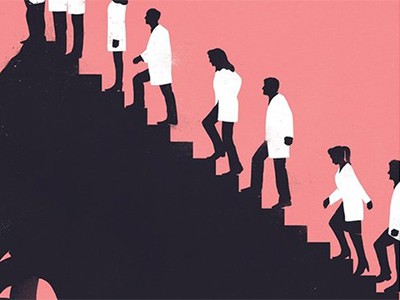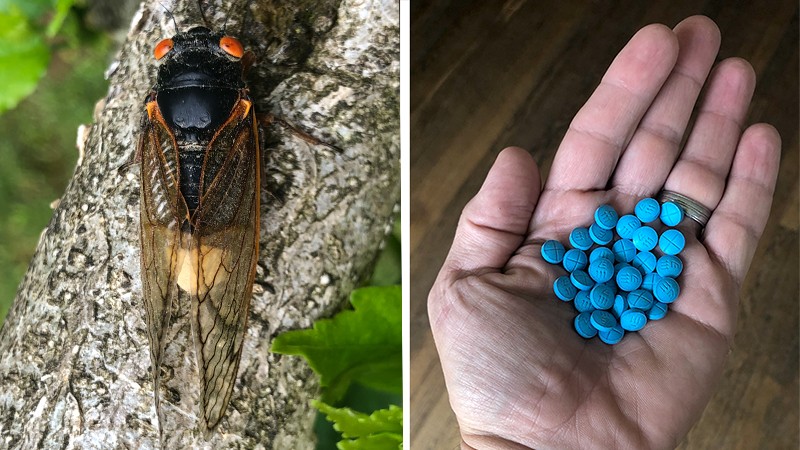Finding mental-health clarity under pandemic pressures - Nature.com
In 2017, my PhD student and I discovered that 13- and 17-year-old cicadas infected with the fungus Massospora cicadina had trace amounts of the amphetamine cathinone inside their fungus-filled abdomens. Little did I know that four years later, during a global pandemic, I would be prescribed the same class of stimulants to address my long-untreated mental disorder.
I first experienced severe depressive episodes punctuated by long bouts of hypomania (higher activity or energy levels than usual) when I was an undergraduate studying forestry and forest ecosystem science from 1998 to 2001. I was hospitalized and withdrew from my second university for a year and a half (often considered a big red flag on a CV). These symptoms were misdiagnosed as bipolar disorder. The underlying hyperactivity and anxiety have followed me for the rest of my scientific career. As distracting as it is, I've learned to live with these symptoms for the past two decades. Only in the past few months have I learned to manage them successfully with medication.
Like many people who live with mental illness, I kept my struggles professionally and personally private. Convinced of my own resilience, I felt I might will my way through my illness by focusing on my education and maintaining a fortified exterior.
During my master's and PhD, I directed my anxiety and hyperfocus towards the study of fungi. Throughout my graduate studies, my symptoms felt more like a superpower: a common and dangerous mischaracterization of anxiety and hyperfocus when harnessed successfully for socially acceptable tasks. I had dozens of all-night work binges (some consecutively) and generated mountains of data. This probably encouraged and emboldened my unhealthy work habits. But it felt good to be noticed for my devotion and productivity. The sobering reality is that graduate programmes are still structured to reward those who excel in their studies, with little attention given to the costs of getting there. Some institutions, including the ones I attended and where I work, have made great strides in addressing these issues in recent years, whereas other institutions have made little progress.

How Zoom helped the neurotypical world hear my autistic voice
By 2014, after a two-year postdoc and more than a decade without psychiatric intervention or therapy, I started my job as a faculty member at West Virginia University in Morgantown, where I am now a tenured associate professor of mycology and plant pathology. Before I earned tenure in 2020, I was consumed by my work with little regard for my own mental health.
Some people witnessed my inattention to various aspects of my personal life. The administrative side of my faculty job, as well, continued to slide and present problems. Receipts and reports were turned in late, and my to-do list piled up, but I reassured myself that this was simply life in academia.
When the pandemic hit, my few remaining coping mechanisms buckled under the weight of accumulating tasks. Celebrating my tenure during the pandemic felt hollow in many ways: I felt as if I was being pulled equally in three directions as I coordinated schooling three young children at home, while giving virtual lectures and running a bustling laboratory, with limited opportunities for the personal interactions with my students and lab members that I craved.

Collection: Science careers and mental health
A year and a half into the pandemic I had reached a point where I knew I needed help. I scheduled appointments with both a therapist and a psychiatrist after a 19-year hiatus from attending to my mental health. My psychiatrist provided a diagnosis of attention-deficit hyperactivity disorder (ADHD) and generalized anxiety disorder (GAD). Diagnoses are bittersweet — providing relief, but also frightening uncertainty. Unlike bipolar disorder, ADHD and GAD and the drugs used to treat them (such as Adderall and Prozac), are familiar to many people. Some people know colleagues or family members with these disorders. This awareness makes ADHD and GAD feel less stigmatized, but they can nonetheless be misperceived. Most people don't understand the crippling effects of these conditions, individually or combined, when left undiagnosed and untreated. Barriers (for example, free time, cost of medications and stigma) limit access to diagnosis and treatment. Neither do people understand that some of us with ADHD and GAD can temporarily leave our anxiety unattended to hyperfixate on our work, often with successful outcomes.
Experiencing pathological hyperfocus and tempered anxiety in academia can be disorienting, because it might signal success and mental well-being to others. My output increased significantly during the first year of the pandemic: I published more papers, secured more grants and received departmental, university and national society awards. I worked frenetically day and night, editing manuscripts, writing grant proposals, pre-recording lectures, and I pushed myself past the brink of exhaustion and burnout. The line between my work and personal life dissolved entirely.

Collection: Life in the lab
There's a natural temptation among scientists to draw parallels between our study organisms and ourselves. That's true for myself and the infected cicadas I study. As a mycologist, I also acknowledge parallels between society's mycophobia (a fear of fungi and mushrooms) and my hesitation to advocate for my own mental health. As I find clarity in my own diagnosis, I realize that my long-term relationship with fungi has taught me how to challenge cultural stigma. Perhaps one day people will talk as easily about the benefits of therapy and psychiatric medications as we do about the various beneficial roles that fungi have in the world around us.
It took me decades and a global pandemic to prioritize my own mental health. It remains a long journey to destigmatize my own mental illness and find happiness and acceptance in who and what I am. With the right combination of medications and therapy I'm discovering the true meaning of balance. Being open about my own mental disorder doesn't diminish my value and contributions as a scientist. Honestly, the truth feels like a second chance. It's also important to acknowledge the many layers of privilege that enable me to speak more freely about mental health. As a white, male, tenured professor, I have benefited from the current biases built into the system, considering my neurotypical public identity throughout most of my career.
Many scientists, particularly early-career scientists, continue to suffer in silence with the perpetual fear of having their mental illness outed. It's never too late to seek professional support for your mental health. Even before I had my diagnosis, ADHD and GAD were always part of my identity. The contributions and perspectives of neurodivergent scientists, including myself and many reading this, enrich academia and contribute to a healthier environment for those pushing the limits of scientific knowledge.

Comments
Post a Comment